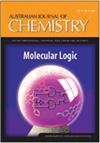具有镇痛作用的concontoxin Vc1.1及其类似物的发现与优化
IF 0.9
4区 化学
Q4 CHEMISTRY, MULTIDISCIPLINARY
引用次数: 0
摘要
墨尔本大学的一个研究小组在西澳大利亚布鲁姆的一个海滩上收集了一种海锥蜗牛的标本,发现了α-螺毒素Vc1.1,这种毒素对啮齿动物有镇痛作用。这种毒液衍生肽的发现导致了一系列的结构,机制和药理学研究,旨在开发一种新的神经性疼痛镇痛药。固相肽合成在构建结构-活性关系方面起着重要作用。对神经性疼痛大鼠模型的研究表明,该肽的环状类似物cVc1.1具有与加巴喷丁相当的镇痛活性,而加巴喷丁是临床上最常用的神经性疼痛药物之一,口服cVc1.1的剂量比加巴喷丁低120倍。最初,Vc1.1被认为主要通过烟碱乙酰胆碱受体起作用,但后来出现了通过γ-氨基丁酸B (GABAB)受体介导的机制证据。优化Vc1.1类似物的结合和药理学性质的努力表明,对任一受体的亲和力都可以通过序列突变、二硫键修饰和主链环化来调节。本帐户描述了Vc1.1的发现、结构、化学和药理学,重点介绍了在澳大利亚实验室进行的研究。本文章由计算机程序翻译,如有差异,请以英文原文为准。
Discovery and optimisation of conotoxin Vc1.1 and analogues with analgesic properties
A specimen of the marine cone snail Conus victoriae collected from a beach in Broome, Western Australia, by a group from The University of Melbourne led to the discovery of the α-conotoxin Vc1.1, which was found to have analgesic activity in rodents. The discovery of this venom-derived peptide led to a series of structural, mechanistic and pharmacological studies directed towards the development of a new analgesic for neuropathic pain by groups in Australia and internationally. Solid-phase peptide synthesis played an important role in developing structure–activity relationships. Studies in a rat model of neuropathic pain showed that a cyclic analogue of the peptide, cVc1.1, had comparable analgesic activity with that of gabapentin, one of the foremost clinically used drugs for neuropathic pain, with cVc1.1 delivered orally at a 120-fold lower dose than gabapentin. Originally, Vc1.1 was believed to act primarily through nicotinic acetylcholine receptors, but evidence for a mechanism mediated through γ-aminobutyric acid B (GABAB) receptors later emerged. Efforts to optimise the binding and pharmacological properties of analogues of Vc1.1 revealed that the affinity towards either receptor can be modulated by sequence mutations, disulfide bond modifications and backbone cyclisation. This Account describes the discovery, structure, chemistry and pharmacology of Vc1.1, with a focus on studies carried out in Australian laboratories.
求助全文
通过发布文献求助,成功后即可免费获取论文全文。
去求助
来源期刊

Australian Journal of Chemistry
化学-化学综合
CiteScore
2.50
自引率
0.00%
发文量
65
审稿时长
1.3 months
期刊介绍:
Australian Journal of Chemistry - an International Journal for Chemical Science publishes research papers from all fields of chemical science. Papers that are multidisciplinary or address new or emerging areas of chemistry are particularly encouraged. Thus, the scope is dynamic. It includes (but is not limited to) synthesis, structure, new materials, macromolecules and polymers, supramolecular chemistry, analytical and environmental chemistry, natural products, biological and medicinal chemistry, nanotechnology, and surface chemistry.
Australian Journal of Chemistry is published with the endorsement of the Commonwealth Scientific and Industrial Research Organisation (CSIRO) and the Australian Academy of Science.
 求助内容:
求助内容: 应助结果提醒方式:
应助结果提醒方式:


